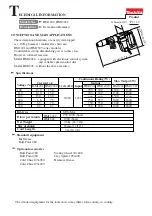
4
2015 series Pneudraulic Installation Tools
(HK958)
Description
The
2015
series tools are lightweight, high-speed production
tools that install 3/32” and 1/4” nail-type blind fasteners. An
integral nose assembly increases reliability and simplifies use of
this tool.
The
2015V
model has a Tubing & Slide Assembly - a ribbed
“ON/OFF” vacuum-regulating slider that enhances the tool
capabilities by expelling broken pintails into the pintail
collector, and holding fasteners firmly in the nose assembly,
with the tool in any position.
When the tool is not in use, the OFF position (slider forward)
will prevent air loss. See Figure 5 for the location of this
assembly (pictured in the ON position) on the tool.
The pulling action of the pull piston is provided by a
pneumatic-hydraulic (pneudraulic) intensifier system that
is powered by 90 psi (6.2 bar) air pressure. The air inlet is
equipped with a connector with 1/4”-18 female pipe threads to
accept your air hose or quick-connect fitting. The piston return
stroke is spring actuated.
Specifications
STROKE:
0.683 in (1.73 cm)
WEIGHT:
2015
: 4.9 lbs (2.22 kg)
2015B
&
2015V
: 5.2 lbs (2.36 kg)
MAX AIR PRESSURE:
90 psi (6.2 bar)
MAX FLOW RATE:
4.3 scfm (121.76 l/min)
POWER SOURCE:
90 psi (6.2 bar) maximum shop air
MAX OPERATING TEMP:
125° F (51.7° C)
PULL CAPACITY:
2670 lbs @ 90 psi
(11.88 kN @ 6.2 bar)
SPEED / CYCLES:
30 per minute
HOSE KITS:
Use only genuine Huck Hose Kits rated @ 10,000
psi (689.5 bar) working pressure.
HYDRAULIC FLUID:
Hydraulic fluid shall meet DEXRON
®
III,
DEXRON VI, MERCON
®
, Allison C-4 or equivalent Automatic
Transmission Fluid (
ATF
) specifications. Fire-resistant fluid may
be used if it is an ester-based fluid such as Quintolubric
®
HFD
or equivalent. Water-based fluid shall NOT be used as serious
damage to equipment will occur.
DEXRON
is a registered trademark of General Motors Corp.
MERCON
is a registered trademark of Ford Motor Corp.
Quintolubric
is a registered trademark of Quaker Chemical Corp.
PULL STROKE:
When tool is connected to the air supply, the
air pressure holds the throttle valve in the up
(RETURN) position; air pressure is directed
to the top of the air piston, keeping it down.
When the trigger is pressed, the throttle
valve moves down to the PULL position, and
pressurized air is directed to the bottom of
the air piston, causing it to move upward.
The air above the air piston is exhausted and
directed through the center of the throttle
valve and out the bottom of the tool (through
the muffler). As the hydraulic piston rod
moves upward, a column of pressurized fluid
is forced into head, which moves the pull
piston rearward. The attached nose assembly
moves with the pull piston to start fastener
installation.
RETURN STROKE:
When fastener installation is completed, the
trigger is released. Air pressure, with the
assistance of a spring, sends the throttle valve
to the up (RETURN) position. Pressurized air
is re-directed to the top of the air piston (see
above), causing it and the hydraulic piston rod
to move downward. The air from below the
piston is exhausted through the bottom of the
tool. The piston and hydraulic piston rod move
downward, hydraulic pressure is reversed, and
the pull piston is returned forward.
Principle of Operation





































